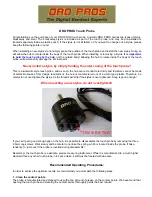
51
english
Jabra PrO 9460, 9460-DuO anD 9470 user manual
dealing with denSity iSSueS
8.15
DeCt technology uses low-power radio technology for wireless transmission. because DeCt uses a dedicated
radio-frequency band, it is relatively immune to interference from other products using radio technologies
commonly used in offices such as wireless routers or wireless networks. likewise, DeCt will not interfere with wifi
networks.
you might, however, experience some performance degradation if you install many Jabra PrO headsets in
one area – the limits are explained below. DeCt has a built-in automatic channel-allocation which attempts to
allocate channels in a way which minimizes the likelihood of interference. the number of channels is always
limited, which may have some implications for large scale deployment.
Performance issues manifest themselves as audible clicks and pops. In the most severe cases, they manifest
themselves as the inability for some headsets to establish the wireless link.
the basic limit you should be aware of is the number of headsets in one area before DeCt channels are re-used:
- 80 headsets for eu DeCt (normal audio), or 40 headsets for eu DeCt (wideband audio)
- 45 headsets for us DeCt (normal audio), or 22 headsets for us DeCt (wideband audio)
the use of wideband audio gives an additional constraint as wideband audio reduces the number of headsets by
a factor of 2.
If the number of headsets in any one area is below the limit indicated above, there should be no performance
issues. even in those lower density situations, you are advised to separate bases from each other by at least 2 - 4m.
If you exceed the density limits, you should configure the products to operate in low-power mode. you must plan
using the following conservative average areas per headset and base-to-base distances:
- 25m
2
– 49m
2
for eu DeCt (i.e 5 – 7m between bases).
- 49m
2
– 100m
2
for us DeCt (i.e. 7 – 10m between bases).
be aware of the fact that large metal objects or large glass windows, especially those covered with a metallic
layer, create many radio reflections. this forces you to plan even more conservatively. the average areas are valid
for an average headset-to-base distance of < 5m — otherwise more conservative planning is needed.
the area referred to above depends on the building layout. It could be an open space office, or a set of collocated
offices separated by lightweight walls. Offices far apart, say >100m apart, or shielded by heavy concrete walls
should not be considered one area. the above planning figures are valid if most users are near their bases
(< 3m distance). If most users are > 5m away from their bases, you should roughly double the recommended area.
















































